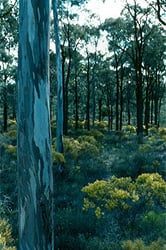Box Ironbark catalogue

In October 2002 the Victorian State Parliament passed the National Parks Bill, proclaiming the Greater Bendigo National Park.
La Trobe's Bendigo campus includes a section of preserved bushland adjoining the Greater Bendigo National Park, which puts the campus in a unique position to contribute to the knowledge of the Box-Ironbark forests.
This image bank aims to increase our appreciation of the Box-Ironbark forests by providing access to images of their smaller components – those that generally escape the casual visitor or bushwalker.
Pollen grains are intrinsically beautiful but also lend themselves to much speculation and experimentation about the evolution of the flower and its pollinator. Our pollen grain images have been taken with a light microscope as well as a scanning electron microscope.
The Box-Ironbark image collection was collated and used for teaching in former subjects run through the Bendigo campus. Photo credits to Katherine Legge and Sabine Wilkens.
Asteraceae
Bracteantha viscosa (Sticky Everlasting), Craspedia glauca (common Billy-button), Microseris scapigera (Yam Daisy), Olearia tubiliflora (Quill Daisy), Ozothamnus obcordatus (Grey Everlasting), Podolepis jaceoides (Showy Podolepis).
Asparagaceae
(Previously Liliaceae) Arthropodium strictum (Chocolate Lily) and Thysanotus patersonii (Twining Fringe Lily).
Goodeniaceae
Brunonia australis (Blue Pincushion).
Campanulaceae
Wahlenbergia stricta (Tall Bluebell).
Colchicaceae
Burchardia umbellata (Milkmaids) and Wurmbea dioica (Early Nancy).
Droseraceae
Drosera macrantha (Climbing Sundew) and Drosera whittakerri (Scented Sundew).
Fabaceae
Dillwynia cinerascens (Grey Parrot Pea), Dillwynia sericea (Showy Parrot-pea), Hardenbergia violacea (Purple Coral-pea/False Sarsaparilla) Hovea linearis (Common Hovea) and Daviesia ulicifolia (Gorse Bitter Pea).
Geraniaceae
Pelargonium rodneyanum (Magenta Stork's-bill).
Mimosaceae
Acacia acinacea (Gold Dust Wattle), Acacia aspera (Rough Wattle), Acacia genistifolia (Spreading Wattle), Acacia paradoxa (Hedge Wattle) and Acacia pycnantha (Golden Wattle).
Myrtaceae
Eucalyptus tricarpa (Red Ironbark) and Melaleuca decussata (Totem Poles).
Orchidaceae
Caladenia catenata (Pink fingers), Caladenia caerulea (Blue Caladenia), Calochilus robertsonii (Purplish beard orchid), Diuris pardina (Leopard Orchid), Glossodia major (Wax-lip Orchid), Thelymitra megacalyptra (Scented Sun-orchid) and Thelymitra rubra (Salmon Sun-orchid).
Asphodelaceae
(Previously Liliaceae) Dianella revoluta (Black Anther Flax-lily).
Pittosporaceae
Bursaria spinosa (Sweet Bursaria).
Proteaceae
Grevillea alpina (Cat's Claws) and Hakea decurrens (Silky Hakea).
Rutaceae
Philotheca verrucosa (Fairy Wax Flower/Bendigo Wax).
Thymelaeaceae
Pimelia humilis (Common Rice Flower).
Elaeocarpaceae
Tetratheca ciliata (Black-eyed Susan/Pink Bells).
Images of the Box-Ironbark forests' larger components are available on the CD-Rom 'Plants and Animals of the Box Ironbark Area of Central Victoria.'
